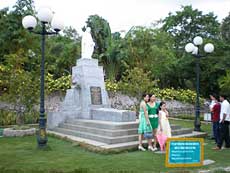A tour to Quy Nhon is not complete without a visit to a national relic – the grave of poet Han Mac Tu in Ghenh Rang Hill.

Quy Nhon is a port town which traces its roots back to the last kingdom of Champa people in the tenth century who built the My Son Sanctuary which has been recognized as a world heritage by UNESCO.
Quy Nhon City is one of the most beautiful cities in the central region and is endowed with sea, mountains, lagoons and a beautiful bay.
Around two kilometers southeast of the center of the city is Ghenh Rang Tien Sa tourist area, a must-see destination for tourists. It has a hill covered by green trees and is striking with a stone cliff directing to the sea at the end section of Xuan Van Mountain 500-1,000 meters above sea level in the Truong Son Mountain Range.
Eighty years ago, the last king of the Nguyen Dynasty, Bao Dai loved this place so much he built a hotel for the royal family’s relaxation at the foot of the mountain. Now, there is a complex of hotels to serve tourists who relax at Hoang Hau (Queen) Beach following in the footsteps of Queen Nam Phuong, wife of King Bao Dai, who would bathe and relax there.
Visiting the grave of Tu is a more somber affair. After tramping around the hill under the shade of betel trees, tourists will see a white stone grave in an area surrounded by trees and flowers. The fragrance of the trees and murmurs of waves in the distance together with whispers of wind though leaves will make travelers feel they are straying into a fairytale location.
Tu is well-known as a talented but melancholic poet. His poems emerged in Vietnamese poetry circles during the 1920s-1930s as the heart-broken voice of a young soul who suffered leprosy, an incurable disease at that time.
His inner voice has stirred millions of hearts and his poems are loved and respected by many Vietnamese people. People visiting this area of Vietnam are intrigued by stories of the life and career of the tragic poet.